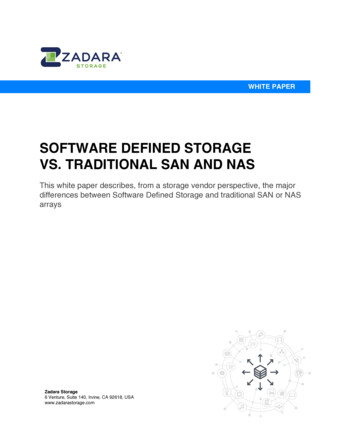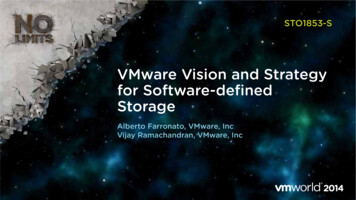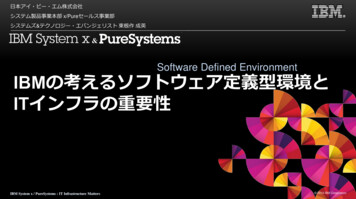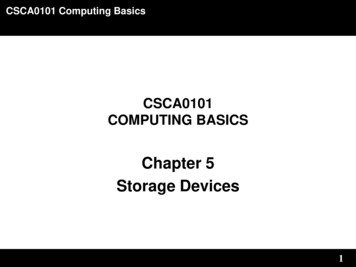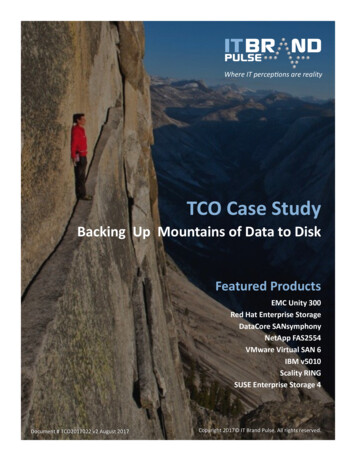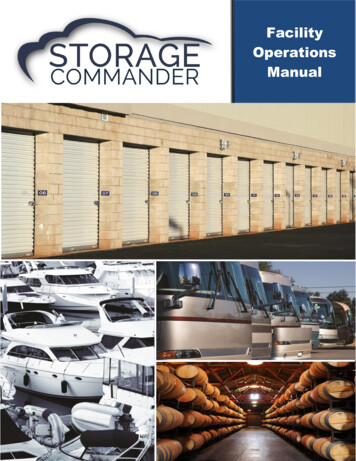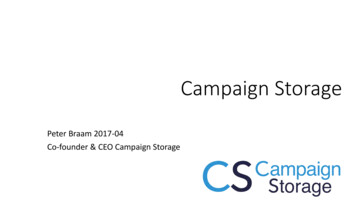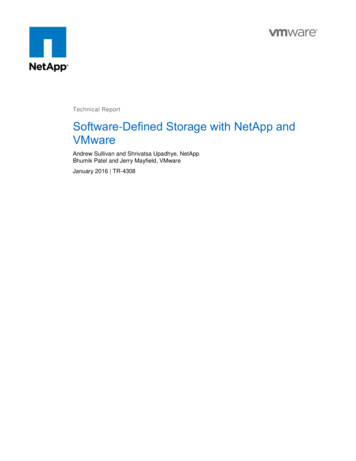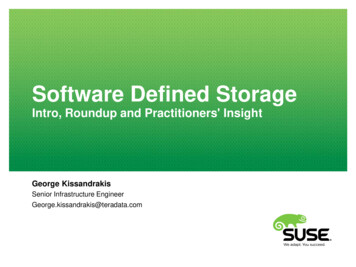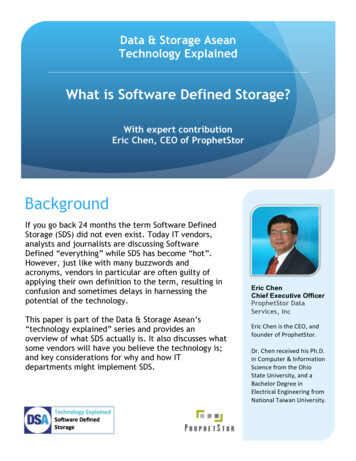
Transcription
Data & Storage AseanTechnology ExplainedWhat is Software Defined Storage?With expert contributionEric Chen, CEO of ProphetStorBackgroundIf you go back 24 months the term Software DefinedStorage (SDS) did not even exist. Today IT vendors,analysts and journalists are discussing SoftwareDefined “everything” while SDS has become “hot”.However, just like with many buzzwords andacronyms, vendors in particular are often guilty ofapplying their own definition to the term, resulting inconfusion and sometimes delays in harnessing thepotential of the technology.This paper is part of the Data & Storage Asean’s“technology explained” series and provides anoverview of what SDS actually is. It also discusses whatsome vendors will have you believe the technology is;and key considerations for why and how ITdepartments might implement SDS.Eric ChenChief Executive OfficerProphetStor DataServices, calEngineeringfromNationalTaiwanUniversity.
12What is Software DefinedStorage?SDS is a data storage methodology in whichthe management and function of thestorage, usually controlled by software, iscompletely separated from the actualphysical storage hardware including mediaand controllers. More than this SDS is anapproach to managing storage by functionand service rather than by hardware.SDS provides one simplified managementplatform that enables the simplifiedmanagement of all and any storage relatedtasks across storage hardware from multiplevendors.The aim of SDS is to remove the complexityof managing storage hardware, and enablemanagement of storage by function andservice. Allocation of hardware to achievethese functions and service levels is anautomated function of the SDS system itself.SDS will also drive efficiencies by creating alayer of abstraction over storage hardwareand enabling storage functions to lever offany type of hardware from commodity Just aBunch of Disks (JBOD) to enterprise arrays.SDS is part of a stack of technologies thatwork together in order to deliver what hasbeen tagged as the “Software Defined DataCenter” (SDDC). A SDDC comprise of threedefined components:1 - Software Defined Compute2 - Software Defined Networking3 - Software Defined StorageThese three components need to integrateseamlessly but exists separately. Eachfunction has to be discrete as the challengeof each area is entirely different. It shouldbe stated however that implementing SDS isnot dependent on it being part of a softwaredefined data centre (SDDC).Are Virtual Volumes the sameas Software Defined Storage?Confusion exists over the difference betweenvirtualised volumes and SDS. The concept ofvirtualised volumes was pioneered bycompanies like Veritas (now Symantec) withtheir Foundation Suite product.Strictly speaking virtualising a volume is acomponent of a total SDS solution. A VirtualVolume is one of the key aspects of storageabstraction. By using disk virtualisation,multiple physical platters can be presentedand managed as a single volume.It should be clear that true SDS meansvirtualising arrays and disks from differentvendors, possibly stored in differentlocations. Many hardware storage vendorshave developed unique, proprietarytechniques to enable value-added services.SDS needs to mimic this in-built intelligencein the hardware, and provide a number ofpopular storage management functions2
12Software Defined Storage - The Key Components to look forOrchestrationIntelligenceDefined as a control and managementlayer that is removed from the physicalstorage, orchestration enables themanagement of numerous types of storagefrom different vendors. The type ofhardware itself becomes less importantthan the performance and features of thestorage. Orchestration enablesmanagement by service level and functionrather than storage hardware.Another key feature differentiating SDSfrom virtualised volumes is SDS’ inherentlevel of “intelligence” or “understanding”of the storage hardware that it isabstracting and orchestrating. This iscritical to managing storage by servicelevel. By understanding the characteristicsof the hardware it is abstracting The SDSplatform can pool together differenthardware based on criteria likeperformance that are then made availableto applications or servers based on therequired performance characteristicsrequired.EncapsulationThink of encapsulation as the StorageHypervisor that sits over the storage arraycreating a virtual rather than physicalview of the storage. The concept behindencapsulation is very similar to the idea ofVirtual Volume Management such as theFoundation Suite pioneered by Veritas.For some vendors their SDS solution isreally nothing more than encapsulation(the virtualising of storage). In reality, itis better to think of encapsulation as acomponent of a total SDS implementation.SeparationManagement or control should beseparated from the data path. This is akey element for truly scalable SDS. Bymoving control out of the data path,performance is not compromised.Applications still get direct connection tothe physical storage without theOrchestration layer becoming an extralayer between the data and theapplication or server.ElasticitySDS is a critical development in support ofcloud-based computing. Whilst you do notneed to be a cloud provider or build aprivate cloud to benefit from SDS, it is truethat cloud and XaaS is a key driver behindSDS. Essentially every aspect of cloudbased computing should be as “elastic” aspossible. This means you grow and shrinkyour consumption of IT resources based onyour needs – minute to minute or hour tohour. Compute, networking and storageneeds are never required in a linear fashion(e.g. your need for compute resources maydecrease whilst storage increases). SDSneeds to integrate seamlessly into thecloud infrastructure but enableadministrators to effortlessly grow andshrink allocated storage by user orapplication or business as required.3
43Software Defined Storage - The Key Components to look forCon’t Management SimplicityPredictive CapabilitySDS should provide a single platform thatenables complex tasks to be managedeffortlessly. An analogy we can use toexplain this is that of an F16 fighter pilot.The technology they control to make theplane function is incredibly complex.However it has been abstracted andautomated so that the pilot does not need tomake any complex calculations to controlthe plane. This simplification allows thepilot to focus on what they do best – flyingthe F16!It makes sense for an SDS platform to beable to calculate and predict future storagerequirements. This capability is currently notcommonly found in many existing SDSsolutions, but the nature of SDS meansbuilding in predictive capability is eminentlypossible. By predicting storage requirementsSDS can automatically re-allocate resourcebased on analysis of what is going to berequired.SDS is the same, administrators should needonly to define the class of storage they wantto provide and the SDS platform should havethe intelligence to mobilise the underlyinghardware to deliver. The skill and trainingrequired to manage a complex storageinfrastructure is reduced by implementingSDS.Utilise Commodity HardwareSDS should be able to incorporate commodityhardware into the pooled abstractedstorage. This should include not just storagehardware but commodity servers with builtin storage in order to deliver enterprise classperformance from commodity components.Application API’sAnother critical feature of a fully roundedSDS implementation is that it cancommunicate effectively with theapplications it supports. Application APIsensure that applications can still access datadirectly from the underlying storage viahypervisors.4
65What about Vendor SpecificSDS solutions?SDS is currently a “hot topic” and we areseeing many vendors coming to market withtheir version of ‘software defined storage’offerings.Inevitably this can cause confusion and raisesthe question as to whether some of thesevendor specific solutions are truly softwaredefined.As an example is VMware’s Virtual SAN, whichon one level is software defined storage inthat it virtualises storage under serverhypervisors. However whilst the technology isgood and offers many excellent features in aVMware-based environment, it may not becompletely right to classify it as a truly opensoftware defined storage solution. Thestorage hypervisor sits within the computehypervisor, which means that there is noseparation of control and data path. Inaddition the storage hypervisor does notalways retain all the characteristics of thestorage beneath it. So whilst on one levelVirtual SAN is an example of softwaredefining storage it is not an example of a freestanding open SDS platform.Another example of a SDS based offering isViPR from EMC. The ViPR solution does tickmany of the SDS “boxes” and in manyrespects is an excellent example of SDSremaining true to the principles of what SDSshould be. It includes Open API’s and has acontrol path separate from the storagehypervisor path. However as of this writing,it is limited to providing orchestration ormanagement over the five types of EMCstorage. So for an EMC house the solution isexcellent but at the present time it doesn’thave the ability to incorporate commodity andthird party hardware – an approach common tomany enterprises that have a two or morevendor policy.ConclusionSoftware Defines Storage is an emerging andevolving technology. It is tied together withcloud and the emerging Software Defined DataCentre, although can be implementedindependently of either of these. Whilstvendor specific versions of SDS may not strictlyadhere to all aspects we would expect to seein an open SDS-based implementation theymay well serve the purpose within certainimplementations.For example, Virtual SAN still providesexcellent storage virtualisation within aVMware environment, and if that is all youneed then it’s a great solution with a VMwarehypervisor environment.However if you are looking to truly evolve yourstorage operations to keep pace with evolvingdemands, and want to transform the processof managing storage from a hardware centricmodel to service centric model, then you willneed to look at open and hardware agnosticSDS technologies such as Federator fromProphetStor.The driver for moving to SDS may be veryspecific – such simplifying storagemanagement. However, best practice dictatesthat even if you are making the move from alargely “physical” storage infrastructure to an“abstracted” storage infrastructure, it is highlyrecommend to see beyond this single driver,consider what is possible and what you mayneed as your computing demands change overtime.5
Published by Asia Online Publishing Group Sdn Bhd Asia Online Publishing Group Sdn Bhd 2014This Guide cannot be published in full or part without thewritten permission of the publisher.www.datastorageasean.com6
their version of 'software defined storage' offerings. Inevitably this can cause confusion and raises the question as to whether some of these vendor specific solutions are truly software defined. As an example is VMware's Virtual SAN, which on one level is software defined storage in that it virtualises storage under server hypervisors.
